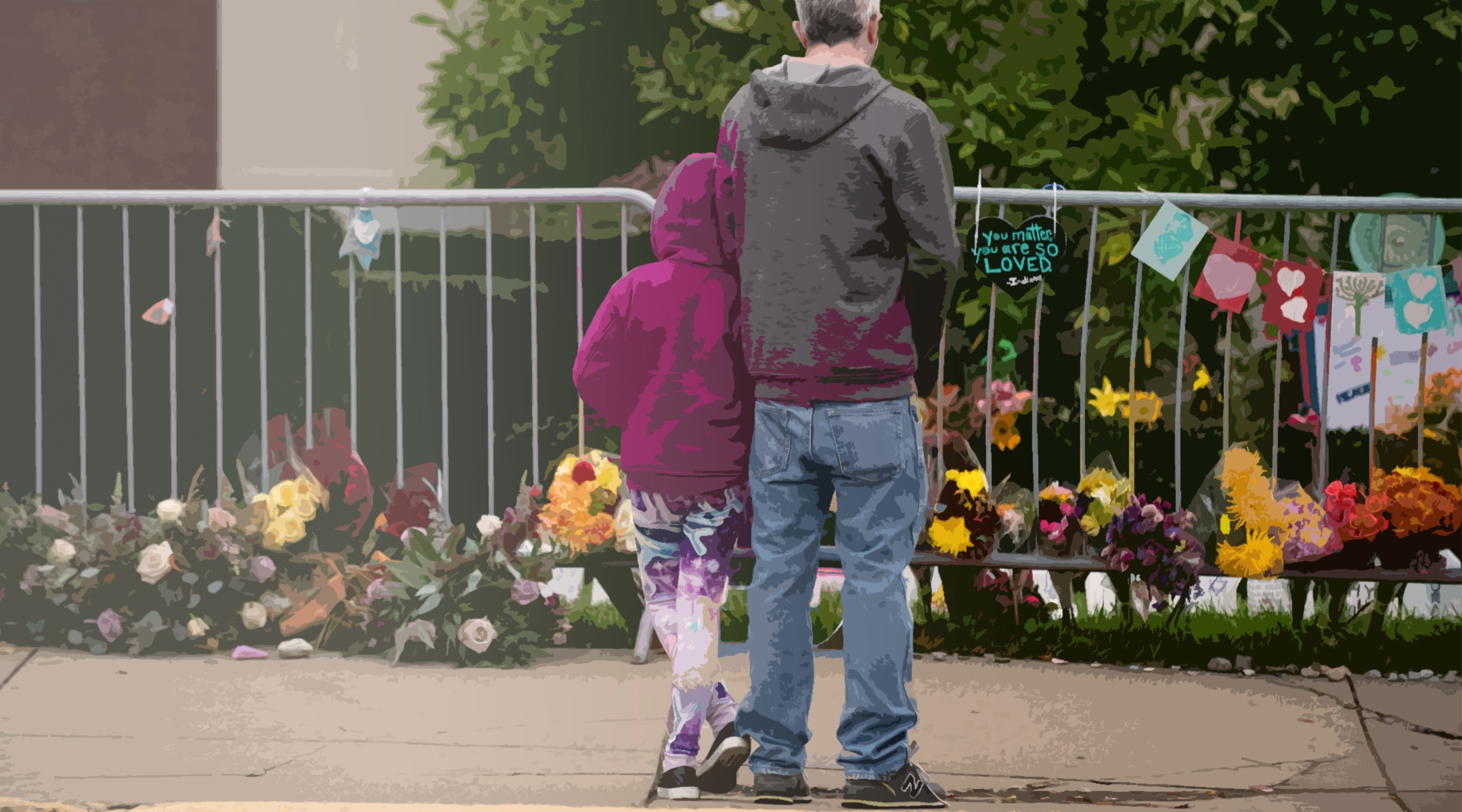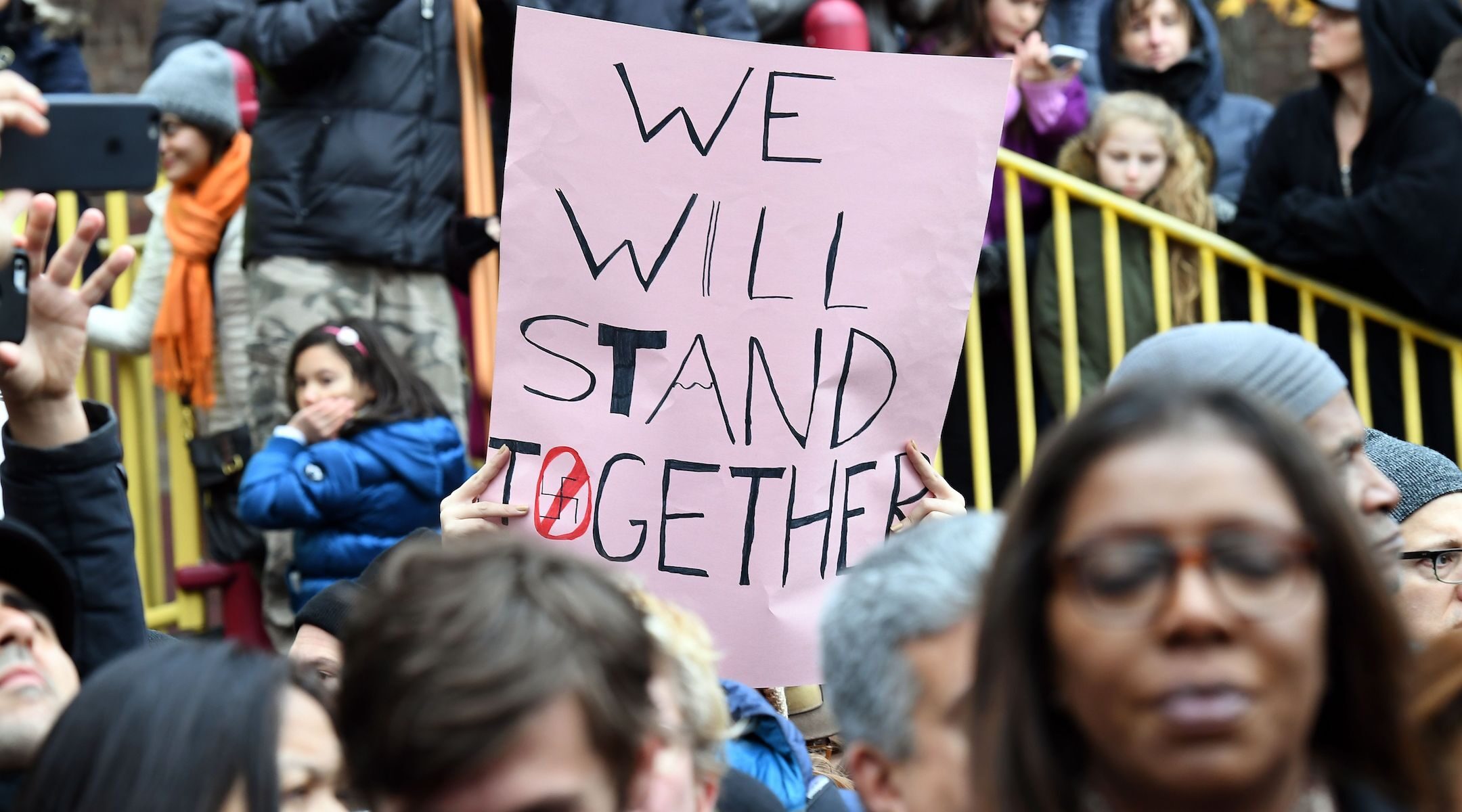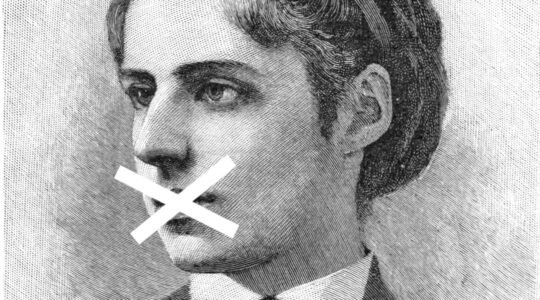(JTA) — My synagogue sent out a cautiously anxious email yesterday about an event coming this Shabbat, a neo-Nazi “Day of Hate.” The email triggered fuzzy memories of one of the strangest episodes that I can remember from my childhood.
Sometime around 1990, in response to local neo-Nazi activity, some Jews from my community decided to “fight back.” I don’t know whether they were members of the militant Jewish Defense League, or perhaps just sympathetic to a JDL-style approach. When our local Jewish newspaper covered the story, it ran on its front cover a full-page photo of a kid from my Orthodox Jewish high school. The photo showed a teenage boy from behind, wearing a kippah and carrying a baseball bat that was leaning threateningly on his shoulder.
As it happens, “Danny” was not a member of the JDL, he was a kid on his way to play baseball. Sometimes, a baseball bat is just a baseball bat. But not for us anxious Jews in America: We want to see ourselves as protagonists taking control of our destiny, responding to antisemites with agency, with power, with a plan. I’m sorry to say that as I look around our community today, it seems to me that we have agency, and we have power — but we certainly don’t seem to have a plan.
The tactics that the American Jewish community uses to fight back against antisemitism are often ineffective on their own and do not constitute a meaningful strategy in the composite. One is that American Jews join in a partisan chorus that erodes our politics and fixates on the antisemitism in the party they don’t vote for. This exacerbates the partisan divide, which weakens democratic culture, and turns the weaponizing of antisemitism into merely a partisan electoral tactic for both sides.
Another tactic comes from a wide set of organizations who have declared themselves the referees on the subject and take to Twitter to name and shame antisemites. This seems to amplify and popularize antisemitism more than it does to suppress it.
A third common tactic is to pour more and more dollars into protecting our institutions with robust security measures, which no one thinks will defeat antisemitism, but at least seeks to protect those inside those institutions from violence, though it does little to protect Jews down the street. Richer Jewish institutions will be safer than poorer ones, but Jews will continue to suffer either way.
A fourth tactic our communal organizations use to fight antisemitism is to try to exact apologies or even fines from antisemites to get them to retract their beliefs and get in line, as the Anti-Defamation League did with Kyrie Irving, an approach that Yair Rosenberg has wisely argued is a no-win proposition. Yet another tactic is the insistence by some that the best way to fight antisemitism is to be proud Jews, which has the perverse effect of making our commitment to Jewishness dependent on antisemitism as a motivator.
And finally, the most perverse tactic is that some on both the right and the left fight antisemitism by attacking the ADL itself. Since it is so hard to defeat our opponents, we have started beating up on those that are trying to protect us. What could go wrong?
Steadily, like a drumbeat, these tactics fail, demonstrating themselves to be not a strategy at all, and the statistics continue to show a rise in antisemitism.
Perhaps we are too fixated on the idea that antisemitism is continuous throughout Jewish history, proving only that there is no effective strategy for combating this most persistent of hatreds.
Instead, we would do well to recall how we responded to a critical moment in American Jewish history in the early 20th century. In the aftermath of the Leo Frank lynching in 1915 – the murder of a Jewish man amid an atmosphere of intense antisemitism — Jewish leaders formed what would become the ADL by building a relationship with law enforcement and the American legal and political establishment. The ADL recognized that the best strategy to keep American Jews safe over the long term, in ways that would transcend and withstand the political winds of change, was to embed in the police and criminal justice system the idea that antisemitism was their problem to defeat. These Jewish leaders flipped the script of previous diasporic experiences; not only did they become “insiders,” they made antisemitism anathema to America itself. (And yes, it was the Leo Frank incident that inspired “Parade,” the forthcoming Broadway musical that this week attracted white supremacist protesters.)
For Jews, the high-water mark of this strategy came in the aftermath of the Tree of Life shooting in Pittsburgh. It was the low point in many ways of the American Jewish experience, the most violent act against Jews on American soil, but it was followed by a mourning process that was shared across the greater Pittsburgh community. The words of the Kaddish appeared above the fold of the Pittsburgh Post-Gazette. That is inconceivable at most other times of Jewish oppression and persecution. It tells the story of when we are successful – when antisemitism is repudiated by the general public. It is the most likely indicator that we will be collectively safe in the long run.
We were lucky that this move to partner with the establishment was successful. I felt this deeply on a recent trip to Montgomery, Alabama. Seeing the memorials to Black Americans persecuted and lynched by and under the very system that should have been protecting them from the worst elements of society is a reminder that not all minorities in America could then — or today — win over the elements of American society that control criminal justice.

Visitors view items left by well-wishers along the fence at the Tree of Life synagogue in Pittsburgh on the first anniversary of the attack there, Oct. 27, 2019. (Jeff Swensen/Getty Images)
A strategic plan to defeat antisemitism that must be collectively embraced by American Jews would build on this earlier success and invest in the infrastructure of American democracy as the framework for Jewish thriving and surviving, and continue the historic relationship-building that changed the Jews’ position in America. It would stop the counterproductive internecine and partisan battle that is undermining the possibility of Jewish collective mobilization.
It means more investment, across partisan divides, in relationships with local governments and law enforcement, using the imperfect “definitions of antisemitism” as they are intended — not for boundary policing, but to inform and help law enforcement to monitor and prevent violent extremism. It means supporting lawsuits and other creative legal strategies, like Integrity First for America’s groundbreaking efforts against the Unite the Right rally organizers, which stymie such movements in legal gridlock and can help bankrupt them.
It means practicing the lost art of consensus Jewish collective politics which recognize that there must be some baseline agreement that antisemitism is a collective threat, even if any “unity” we imagine for the Jewish community is always going to be be instrumental and short-lived.
It means supporting institutions like the ADL, even as they remain imperfect, even as they sometimes get stuck in some of the failed strategies I decried above, because they have the relationships with powerful current and would-be allies in the American political and civic marketplace, and because they are fighting against antisemitism while trying to stay above the partisan fray.
It means real education and relationship-building with other ethnic and faith communities that is neither purely instrumental nor performative — enough public relations visits to Holocaust museums! — so that we have the allies we need when we need them, and so that we can partner for our collective betterment.
And most importantly, it means investing in the plodding, unsexy work of supporting vibrant American democracy — free and fair elections, voting rights, the rule of law, peaceful transitions of power — because stable liberal democracies have been the safest homes for minorities, Jews included.
I doubt we will ever be able to “end” individual antisemitic acts, much less eradicate antisemitic hate. “Shver tzu zayn a Yid” (it’s hard to be a Jew). We join with our fellow Americans who live in fear of the lone wolves and the hatemongers who periodically terrorize us. But we are much more capable than we are currently behaving to fight back against the collective threats against us. Instead, let’s be the smart Americans we once were.
The real work right now is not baseball bats or billboards, it is not Jewish pride banalities or Twitter refereeing: It is quiet and powerful and, if done right, as American Jews demonstrated in the last century, it will serve us for the long term.
JTA has documented Jewish history in real-time for over a century. Keep our journalism strong by joining us in supporting independent, award-winning reporting.







